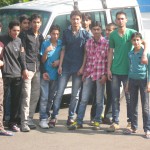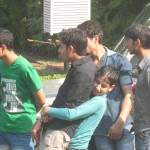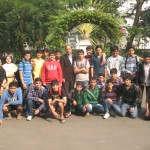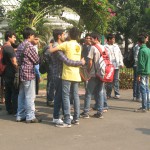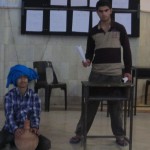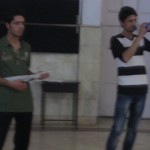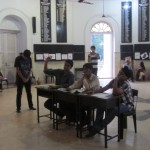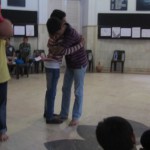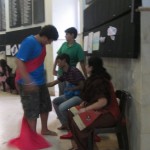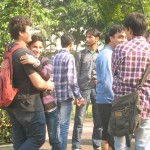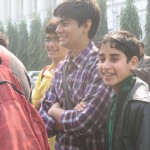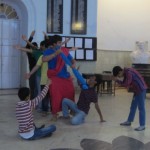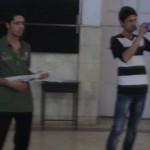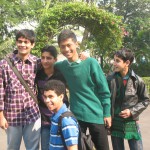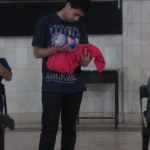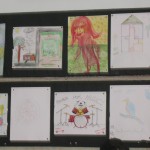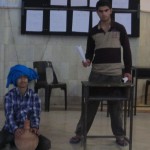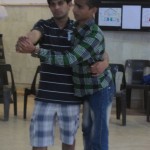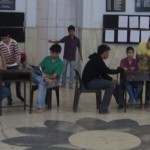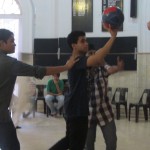An ache,
A fire,
My desire…
A need
I feed
Gorging on the matter
Matter-of-factly on another
Precipitous cannibal
Eats himself inside out,
Outside in
Din, dry noise
This rising hunger
Feeds, even when fed
On its own irrepressible need
The fifth session of the Dialogue for Peace: the Kashmir Project was a platform for young adults from two completely diverse cultural backgrounds to come together and explore their ‘hunger’.
Hunger for what—a sharp one had asked.
Was it the physical experience of hunger, one that could be gratified easily? Or, a monologue of an inner hunger? Or maybe, it was spiritual?
A weeklong process saw them working out the ‘concept of hunger’, until their hunger, lodged somewhere in the meshes of the mind came to the fore.
Conducted by theatre veteran Probir Guha, the theatre workshop incorporated art, music and play apart from theatre games.
Probir Guha got the young adults to come together in a circle and then asked them to introduce themselves. Instead of the usual ice breaking games, he got his troupe members Baban Guha and Tapan Da to teach the participants a folk song on communal integration.
The participants sang the song ‘insaan’ in chorus and with great gusto—
“…na mai masjid mein milta, na mai Mandir mein milta,
na kawa mein na kuran mein, mai to milta insaan mein…”
“…You wont find me in temple or a mosque,
nor in holy kawa nor in Koran, but in hearts of men, I reside..”
A sense of liberation, even ease appeared to settle upon the participants as they internalized the song: that human bond and love is above narrow sectarianism. However, PeaceWorks has never been content with words alone, it seeks to dig deeper, prise open the fragile space of comfort and stimulate the participants to probe and come up with difficult questions.
Was it achieved in seven days? Could it have been?
The days that followed saw them work together and explore performance and theatre. They were often thrown together in situations where they had to coordinate, ‘get each other’s back’ as one said; explore their creativity, desires and capacities. Instinct tells me that sometimes we did succeed, especially, when the young adults worked together to put up a good show, or when they asked a question that stumped us all. At other times, we realized, we had to go an extra mile and make our process less predicable, explore new methods or even tweak the proverbial “well trodden path” to make way for something better. Mostly, to nuance the process and make it more intense, that it may resonate with the young adults and intimately engage them with the process and each other.
Raw and ready to learn, these children were like dry hay, a spark would ignite their fire, a catchy wind would spread the fire far and deep in their minds. There were a few sparks that did catch fire—the song was one such spark and another was the idea of ‘hunger’ as a metaphor for ‘desire’.
Probir da began with an exercise where the participants were asked to direct a still act, one that would represent an aspect of reality that troubled the ‘director’. He could not speak to his chosen actors and yet he had to convey his intent through silence. And then the actors had to enact and make the piece meaningful to the immediate audience. Quite a few presented interesting freezes, and they also made us realize that they were aware of the traffic of current affairs. A young boy from Kashmir represented stone pelting, where as another from Kolkata represented military violence. However, we had just scratched the surface, were we to linger with the performance and the actors and directors, I wonder if we would have opened the tense space of intimacy and sharing? Because, there was this sense that a lot could have been shared. Later when Probir da asked them to analyse the ‘value’ of the exercise, the participants were responsive. Some said that it emphasized that action could speak louder than words; another said that communication was possible even if the words failed; yet another suggested that it cued us to the power of visual representation.
From here they were lead to the theme of hunger. When the children refused to give well thought out answers, Tapan Da represented hunger through mime.
A voluptuous hunger, of the stomach, one that makes a man gorge like a demon, defiling his humanity until he topples and is eaten up by his own hunger.
This performance effectively stopped participants from naming their favourite cuisine when asked about their hunger. Their deeper concerns came to the fore—preserving nature, preventing mindless violence, following ones passion to the end, music, love, humanity and the circle widened farther and farther.
And through the theatre games and processes, the casts of their ideas were concretised and moulded into a form. They were asked to represent their desire through mime— first individually, then in groups of three, then in eight. Later, mime was replaced by an act— using props, voice modulation, gestures and articulation. The performers were constantly provoked to use their creativity and expressivity to the utmost. Even the act of viewing was made more dynamic. The audience was asked to respond and critically engage with the performance.
When the process seemed to slacken, Probir da used a poem on questioning and put it to music. Others were asked to represent this poem through other media. One chose the form of dramatic recitation; another chose freestyle movement to represent the same—diverse means at heart united.
Later they were asked to represent their hunger through art. Young boys squatted, or spread face down, in the round chapel or on the ground and sketched. While some enjoyed, others saw this as an opportunity to gab, lay about and ‘take a well meaning break’.
Leisure was fun for the participants but equally distracting. Not surprisingly, Probir da faced some trouble getting them to concentrate later. And what with young men still preoccupied with their day’s cricket match and incomplete shopping, the intervention lost its momentum for a while.
Probir Da had to reinvent his approach to control the dwindling number of participants. Isolation and characterization, a process developed by him came to the rescue. The process involved creating aesthetic body postures and combining it with facial expression to give the posture a character. This approach effectively brought the participants back on track and the lack of enthusiasm dissipated and in its stead, they looked more determined and interested. The process was repeated for the next few days and gradually from an individual act it got transformed into a group act. The participants ultimately came up with a formation, at the core of which, the idea of ‘hunger for desire’ was made to lodge. Even though it appeared a little administered, yet as the days passed, one felt that the idea was cutting a deeper mark in their minds. In fact when it ended at the end of the sixth day, there was a feeling that a longer and deeper process came to an abrupt end—an end that was cumulative, but at the same time checkered.
But does this mean that the intervention was not successful?
Not really, some participants found that they were rediscovering their selves through art and theatre, others learnt that fun that had taken a back seat in the commerce of life—school, tuitions etc.
And friendship and bond between the two diverse groups, what about it?
Yes, one did witness moments of camaraderie and slipping away of it as well—but isn’t that what happens to every one. We slide in an out of relationships, but at the end of each moment of intimacy, we learn a little more about caring and being with another— looking beyond the private ken, wearing a different lens. Sometimes even wearing a glass, to see things for the first time, clearly and sharply.
A report by Shailza Rai

